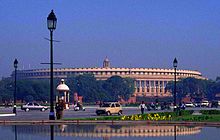This article is about the current Parliament of India. For the Indian legislatures that existed prior to independence, see Imperial Legislative Council.
The Indian Parliament (Devnagari:भारतीय संसद) (Bhāratīya Sansada) is the supreme legislative body in India. Parliament is composed of:
- The President of India
- Lok Sabha (House of the People)
- Rajya Sabha (Council of States).
The president in his role as head of legislature has full powers to summon and prorogue either house of Parliament or to dissolve Lok Sabha. However, in keeping with the Westminster Model of governance, the president rarely exercises such powers without the advice of the prime minister.
India's government is bicameral; Rajya Sabha is the upper house and Lok Sabha is the lower house. The two houses meet in separatechambers in the Sansad Bhavan (located on the Sansad Marg or "Parliament Street") in New Delhi. Those elected or nominated (by the President) to either house of Parliament are referred to as members of parliament or MPs. The MPs of Lok Sabha are directly elected by the Indian public and the MPs of Rajya Sabha are elected by the members of the State Legislative Assemblies, in accordance with proportional representation. The Parliament is composed of 790 MPs, who serve the largest democratic electorate in the world; 814.5 million Indians registered to vote in the 2014 general elections.
Composition
The Indian Parliament consists of two houses called the Lok Sabha and the Rajya Sabhawith the President of India acting as their head.
President of India
Main article: President of India
Similar to most Commonwealth countries, India also includes the president Head of State (the President of India in India's case) as a component of Parliament. The President of India is elected from a group of nominees, by the elected members of the Parliament of India (Lok Sabha and Rajya Sabha) as well as of the state legislatures, and serves for a term of five years. Historically, ruling party (majority in the Lok Sabha) nominees have been elected and ru largely uncontested. The members of Lok Sabha can also be a part of assembly. Incumbents are permitted to stand for re-election, but unlike the president of the United States, who can be elected just twice, incumbents can be elected for any number of terms. However, by convention, only the first President of India has held office for two-five year terms. A formula is used to allocate votes so there is a balance between the population of each state and the number of votes assembly members from a state can cast, and to give an equal balance between State Assembly members and National Parliament members. If no candidate receives a majority of votes there is a system by which losing candidates are eliminated from the contest and votes for them transferred to other candidates, until one gains a majority. The current president of India is Pranab Mukherjea
Lok Sabha
Main article: Lok Sabha
Lok Sabha is also known as the "House of the People" or the lower house and has members from 543 parliamentary constituencies. All of its members are directly elected by citizens of India on the basis of universal adult franchise, except two who are appointed by the President of India. Every citizen of Indiawho is over 18 years of age, irrespective of gender, caste, religion or race, who is otherwise not disqualified, is eligible to vote for the lok sabha.
The Constitution provides that the maximum strength of the House be 552 members. It has a term of five years. To be eligible for membership in the Lok Sabha, a person must be a citizen of India and must be 25 years of age or older, mentally sound, should not be bankrupt and should not be criminally convicted. The total elective membership is distributed among the States in such a way that the ratio between the number of seats allotted to each State and the population of the State is, so far as practicable, the same for all States.[3]
Up to 530 members represent of the territorial constituencies in States, up to 20 members represent the Union Territories and no more than two members from Anglo-Indiancommunity can be nominated by thePresident of India if he or she feels that the community is not adequately represented. House seats are apportioned among the states by population .
A total of 131 seats (18.42%) are blocked for representatives of Scheduled Castes (84) andScheduled Tribes (47) only, in a practice known as reservation. The Women's Reservation Bill proposes reserving 33% of the seats in Lok Sabha for women.
Rajya Sabha
Main article: Rajya Sabha
The Rajya Sabha is also known as "Council of States " or the upper house. Rajya Sabha is a permanent body and is not subject to dissolution; instead one third of the members retire every second year, being replaced by newly elected members. Each member is elected for a term of six years.[4] Its members are indirectly elected by members of legislative bodies of the States.
The Rajya Sabha can have a maximum of 250 members in all. 238 members are to be elected from States and Union Territories and 12 are to be nominated by the President of India and shall consist of persons having special knowledge or practical experience in respect of such matters as the following, namely literature, science, art and social service. The minimum age for a person to become a member of Rajya Sabha is 30 years.
- Representatives of States are elected by the elected members of the Legislative Assembly of the State in accordance with system of proportional representation by means of single transferable vote.
- Representatives of Union Territories are indirectly elected by members of an electoral college for that territory in accordance with system of proportional representation.
The Council of States is designed to maintain the federal character of the country. The number of members from a state depends on the population of the state (e.g. 31 from Uttar Pradesh and one from Nagaland).
Architecture
The parliament is one of the most magnificent buildings in New Delhi. It was designed by Edwin Lutyens and Herbert Baker, who were responsible for planning and construction of New Delhi. The construction of buildings took six years and the opening ceremony was performed on 18 January 1927 by the then Governor-General of India,Lord Irwin. The construction costs for the building were Rs. 8.3 million. The parliament is 570 feet (170 meters) in diameter. It covers an area of nearly six acres. The building has twelve gates among which Gate No. 1 on the Sansad Marg is the main gate.
General layout of the building
The centre and the focus of the building is the Central Hall. It consists of chambers of Lok sabha, Rajya Sabha and the Library Hall and between them lie garden courts. Surrounding these three chambers is the four storyed circular structure providing accommodations for Ministers, Chairmen, Parliamentary committees, Party offices, important offices of Lok Sabha and Rajya Sabha Secretariats and also the offices of the ministry of Parliamentary affairs. The Central Hall is circular in shape and the dome is 98 feet (29.87 meters) in diameter. It is a place of historical importance. The Indian Constitutionwas framed in the Central Hall. The Central Hall was originally used in the library of erstwhile Central Legislative Assembly and the Council of States. In 1946, it was converted and refurbished into Constituent Assembly Hall. At present, the Central Hall is used for holding joint sittings of both the houses of parliament and also used for address by the President in the commencement of first session after eachgeneral election.
Working, procedures proceduresEd
The Parliament consists of the President of Republic of India and both the Chambers. The House and the Council are equal partners in the legislative process; however, the Constitution grants the House of People some unique powers. Revenue-raising or "Money" bills must originate in the Lok Sabha. The Council of States can only make recommendations suggestions over these bills to the House, within a period of fourteen days – lapse of which the bill is assumed to have been passed by both the Chambers.[5]
Session of parliament
The period during which the House meets to conduct its business is called a session. The Constitution empowers the President to summon each House at such intervals that there should not be more than 6-month's gap between the two sessions. Hence the Parliament must meet at least twice a year. In India, the parliament conducts three sessions each year:[5]
- Budget session: In the months of February to May.[5](Longest)
- Monsoon session: In the months of July to September.[5]
- Winter session: In the months of November to December[5](Shortest)
Lawmaking procedures
Main article: Lawmaking procedure in India
Lawmaking procedures in India are modeled after, and are thus very similar to, those followed by the Parliament of the United Kingdom.
Parliamentary committees
Parliamentary committees play a vital role in the parliamentary system. They create a vibrant link between the Parliament, the Executive and the general public.
The need for committees arises out of two factors – the first one being the need for vigilance on the part of the Legislature over the actions of the Executive, while the second one is that the modern Legislature these days is over-burdened with heavy volume of work with limited time at its disposal. It thus becomes impossible that every matter should be thoroughly and systematically scrutinized and considered on the floor of the House. If the work is to be done with reasonable care, some Parliamentary responsibility has to be entrusted to an agency in which the whole House has confidence. Entrusting certain functions of the House to the Committees has, therefore, become a normal practice. This has become all the more necessary, as a Committee provides the expertise on a matter which is referred to it.
In a committee, the matter is deliberated at length, views are expressed freely, the matter is considered in depth, in a business-like manner and in a calm atmosphere. In most of the Committees, public is directly or indirectly associated when memoranda containing suggestions and are received, on-the-spot studies are conducted and oral evidence is taken which helps the Committees in arriving at the conclusions.
Parliamentary committees are of two kinds: ad hoc committees and the standing committees. The most powerful committee is the public accounts committee, which is headed by the leader of the opposition.
Standing committees
Main article: Standing committee
There are standing committees in the Indian Parliament. Each house of Parliament has standing committees like the Business Advisory Committee, the Committee on Petitions, the Committee of Privileges and the Rules Committee, etc. and many more such committees.
Standing committees are permanent regular committees which are constituted from time to time in pursuance of the provisions of an Act of Parliament or Rules of Procedure and Conduct of Business in Parliament. The work of these committees is of a continuing nature. The Financial Committees, DRSCs and some other committees are standing committees.
Ad hoc committees
Ad hoc committees are appointed for a specific purpose and they cease to exist when they finish the task assigned to them and submit a report. The principal ad hoc committees are the Select and Joint Committees on Bills. Others like the Railway Convention Committee, the Committees on the Draft Five Year Plans and the Hindi Equivalents Committee were appointed for specific purposes.
Joint Committee on Food Management in Parliament House Complex etc. also come under the category of ad hoc committees.






No comments:
Post a Comment